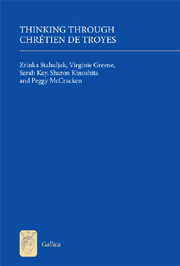Book contents
- Frontmatter
- Contents
- Preface
- Introduction
- 1 The “Changeful Pen”: Paradox, Logical Time, and Poetic Spectrality in the Poems Attributed to Chrétien de Troyes
- 2 Imagination
- 3 Adventures in Wonderland: Between Experience and Knowledge
- 4 Feudal Agency and Female Subjectivity
- 5 Forgetting to Conclude
- Epilogue
- Appendix I Sigla of the Principal Manuscripts of the Chrétien Romances
- Appendix II Lyric Texts, Textual Notes and Translations
- Appendix III Passages from Cligés for Comparison with Lyric Texts
- Appendix IV Variants to the “Cart Scene” in Le Chevalier de la Charrete
- Bibliography
- Index
- Title in the Series
Introduction
Published online by Cambridge University Press: 05 February 2013
- Frontmatter
- Contents
- Preface
- Introduction
- 1 The “Changeful Pen”: Paradox, Logical Time, and Poetic Spectrality in the Poems Attributed to Chrétien de Troyes
- 2 Imagination
- 3 Adventures in Wonderland: Between Experience and Knowledge
- 4 Feudal Agency and Female Subjectivity
- 5 Forgetting to Conclude
- Epilogue
- Appendix I Sigla of the Principal Manuscripts of the Chrétien Romances
- Appendix II Lyric Texts, Textual Notes and Translations
- Appendix III Passages from Cligés for Comparison with Lyric Texts
- Appendix IV Variants to the “Cart Scene” in Le Chevalier de la Charrete
- Bibliography
- Index
- Title in the Series
Summary
Who was Chrétien de Troyes? This is a question that implicitly or explicitly grounds critical readings of the works associated with this name. The construction of a unified corpus is grounded in the premise of single authorship, subtended by an implicit claim to oneness: one author – Chrétien de Troyes – to whom was securely attributed a corpus of five romances. The focus on authorized authorship has tended to marginalize other works associated with or attributed to Chrétien – the lyrics, the short text “Philomena,” and Guillaume d'Angleterre – and in a circular logic, to draw from the romance corpus an identifying style that either renders other works marginal to the Chrétien œuvre or excludes them altogether. Another tendency of the focus on the author and his romances is an evolutionary model of analysis that sees the works in chronological perspective, the latest representing the most mature and definitive pronouncements in light of which his earlier achievements should be read.2
We began work on this book in order to contribute a decisively different, more plural, open, and flexible study of the Chrétien corpus. We were aware that there had for several years been a dearth of new writing dedicated specifically to either the wider or the narrower Chrétien canon. Aside from studies aimed primarily at the student market – such as Joseph J. Duggan's introductory The Romances of Chrétien de Troyes (2001) or the Companion to Chrétien de Troyes (2005) – studies of the Chrétien works in the last decade appeared as only part of larger arguments about medieval culture or poetics.
- Type
- Chapter
- Information
- Thinking Through Chrétien de Troyes , pp. 1 - 14Publisher: Boydell & BrewerPrint publication year: 2011



